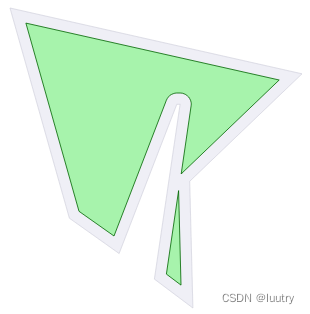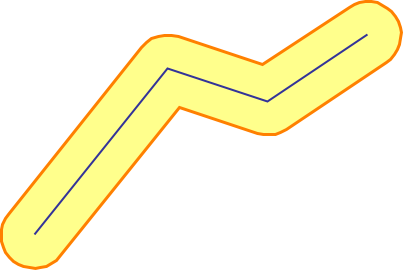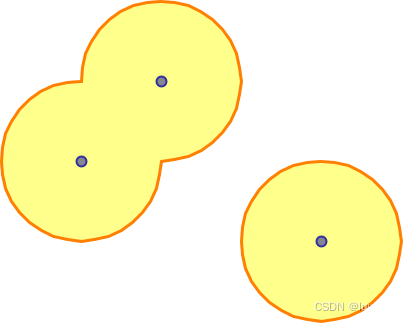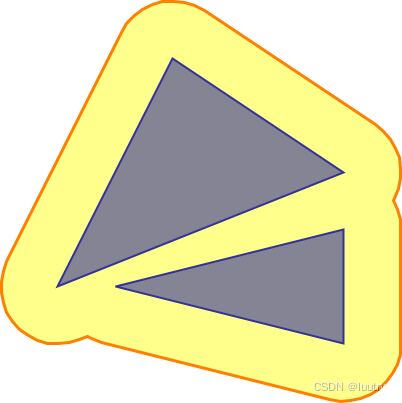-
图形/多段线内缩外扩思路
图形/多段线内缩外扩思路
前言
我在网上找了很多关于多边形内缩外扩的资料,也测试了一些算法库,如
Clipper,boost::geometry::buffer,其实都可以得到不错的结果。Clipper#include "clipper.hpp" ... using namespace ClipperLib; int main() { Path subj; Paths solution; subj << IntPoint(348,257) << IntPoint(364,148) << IntPoint(362,148) << IntPoint(326,241) << IntPoint(295,219) << IntPoint(258,88) << IntPoint(440,129) << IntPoint(370,196) << IntPoint(372,275); ClipperOffset co; co.AddPath(subj, jtRound, etClosedPolygon); co.Execute(solution, -7.0); //draw solution ... DrawPolygons(solution, 0x4000FF00, 0xFF009900); }- 效果

boost::geometry::buffer#include#include #include int main() { typedef double coordinate_type; typedef boost::geometry::model::d2::point_xy<coordinate_type> point; typedef boost::geometry::model::polygon<point> polygon; // Declare strategies const double buffer_distance = 1.0; const int points_per_circle = 36; boost::geometry::strategy::buffer::distance_symmetric<coordinate_type> distance_strategy(buffer_distance); boost::geometry::strategy::buffer::join_round join_strategy(points_per_circle); boost::geometry::strategy::buffer::end_round end_strategy(points_per_circle); boost::geometry::strategy::buffer::point_circle circle_strategy(points_per_circle); boost::geometry::strategy::buffer::side_straight side_strategy; // Declare output boost::geometry::model::multi_polygon<polygon> result; // Declare/fill a linestring boost::geometry::model::linestring<point> ls; boost::geometry::read_wkt("LINESTRING(0 0,4 5,7 4,10 6)", ls); // Create the buffer of a linestring boost::geometry::buffer(ls, result, distance_strategy, side_strategy, join_strategy, end_strategy, circle_strategy); // Declare/fill a multi point boost::geometry::model::multi_point<point> mp; boost::geometry::read_wkt("MULTIPOINT((3 3),(4 4),(6 2))", mp); // Create the buffer of a multi point boost::geometry::buffer(mp, result, distance_strategy, side_strategy, join_strategy, end_strategy, circle_strategy); // Declare/fill a multi_polygon boost::geometry::model::multi_polygon<polygon> mpol; boost::geometry::read_wkt("MULTIPOLYGON(((0 1,2 5,5 3,0 1)),((1 1,5 2,5 0,1 1)))", mpol); // Create the buffer of a multi polygon boost::geometry::buffer(mpol, result, distance_strategy, side_strategy, join_strategy, end_strategy, circle_strategy); return 0; } - 效果



遇到的问题
我现在得到的图形是经过反向解析文件再生成的,每个点位都是包含了一些信息,原始的点位个数和顺序是不可以轻易被改变的,而且图形也不一定是封闭的,其组成是可能带圆弧的多段线,后面再生成的文件还得和原始图形的点位顺序对应上才行。而以上两种处理库,是会改变点传入点位的个数和顺序的,这样的结果并不能正确生成理想的文件,就是这个问题让我很是头疼。
后来尝试找些几何理论的资料来解决,而网上的不少资料都是通过向量的方式来求夹角的,在出现内缩到一定程度,会有自交的情况,需要自己跳过垂直平行重复的点位,显然这也不是我想要的结果。
抛砖引玉
期间想到可以用直线段按照斜率平移的方法来处理,内缩的情况是相邻两线段的交点就是图形新的顶点,而拐角是圆弧的时候,判断圆弧两边的线段平移后有没有交点来决定要不要移除。当然这个办法显然比较笨,但是得到的图形顶点顺序和个数是可控的,也能让我如愿与原始的点位所带的信息对应上。
这里只是记录了思路,具体代码实现省略。附带直线的相关知识。
可以参考大神的实现方法
jbuckmccready/CavalierContours
最后
感谢各位大佬的无私奉献。
- 效果
-
相关阅读:
中南林业科技大学Java实验报告十:常用实用类
开发知识点-人工智能-深度学习Tensorflow2.0
linux中关机和重启命令:shutdown
Rust学习入门
selenium元素定位问题
计算机网络(TCP协议)
AI_Neural Network_Note (二)
分析25个主要DeFi协议的路线图 预见DeFi未来的七大趋势
使用 RAG、Langchain 和 Streamlit 制作用于文档问答的 AI 聊天机器人
[iOS]LLDB调试
- 原文地址:https://blog.csdn.net/yoyo18520/article/details/127114050